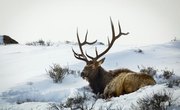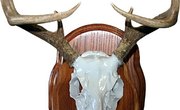
According to the Alaska Department of Fish & Game's website, the deer skull possesses some characteristics that are common to those of all mammals, and others that are specific to the habitat and lifestyle of the deer, which is an herbivore.
Common Aspects
As in all mammals, the skull of the deer comprises three main parts. The first is the braincase, which is the protective bone that encloses the brain. The second is the rostrum, which forms the snout and the upper jaw. The third is the lower jaw. Other bones that are common to mammals are the nasal bones that form the roof of the nasal cavity and the frontal bones that are on the top of the skulls of most antler-growing mammals.
Teeth
A deer's teeth are specific to the animal's classification as a Ruminant, or cud chewer. The deer has several stomach chambers that allow it to chew, swallow, regurgitate and then re-chew the cud of its food. Meat-eating animals have upper incisors to rip meat. Deer, instead of incisors, have a hard palate on the roof of the mouth which presses against the lower teeth. Vegetation is pinched between the lower teeth and the hard palate and ripped out of the ground to be held in the cavity between the lower incisors and cheek teeth. According to the Alaska Department of Fish & Game, the reason for this formation of teeth is to allow the deer to eat large amounts of foliage quickly before retreating to the safety of undergrowth to regurgitate and then re-chew the food.
Eyes
The eye sockets of a deer are positioned on the side of the skull but slightly forward, giving the deer the ability to view a wide area around itself, which is a defensive measure that aids in spotting predators. According to the deer information website "Whitetails," the positioning of the eye sockets on a deer provides a range of vision close to 310 degrees; however, this means that they are not able to focus on the same object with both eyes, resulting in poor depth perception.
Antlers
According to the Alaska Department of Fish & Game, antlers are a living combination of skin and short hair that grows from the top of the skull of a deer. Antler growth is shed annually when a series of cells at the base of the antler and the top of the skull breaks down the bone, allowing the antler to be shed. Deer usually shed their antlers in late winter, and new growth begins quickly, with growth rates of around 1 to 2 inches per week.
Age
As is the case with most vertebrates, the various bones in a deer's skull are not fused together when the animal is born, to allow for growth to take place. The age of an animal can be estimated by examining the the lines between the separate parts of the skull, which are usually fused together by the time maturity is reached.
References
Writer Bio
Paul Cartmell began his career as a writer for documentaries and fictional films in the United Kingdom in the mid-1990s. Working in documentary journalism, Cartmell wrote about a wide variety of subjects including racism in professional sports. Cartmell attended the University of Lincoln and London Metropolitan University, gaining degrees in journalism and film studies.



